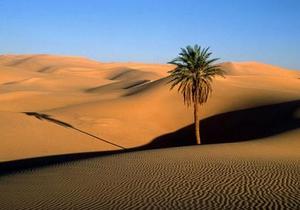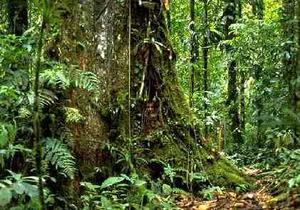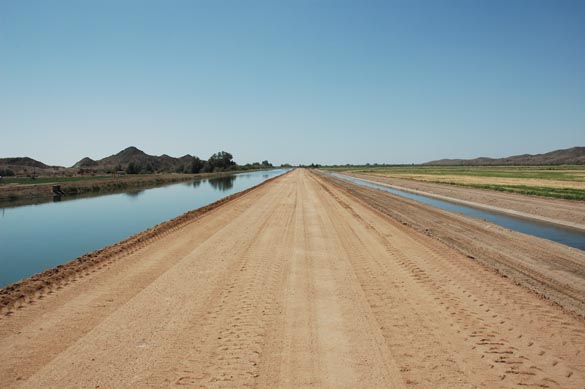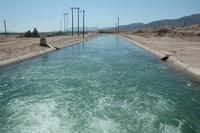|
• The settlement of less-than-optimal lands • |
♦ Water and nutrients ♦
Water and nutrients are fundamental natural resources; yet they are at odds at both extremes of the climatic spectrum.
Where there is plenty of water, nutrients are in short supply; conversely, where there is very little water, nutrients abound.
Ecosystems need both water and nutrients
in sufficient quantities; therefore, the resource dilemma.
In humid regions, where rainfall is more than 1600 mm per year,
nutrients have been leached through millennia and only limited quantities remain in the soil profile. For instance, in tropical
rainforests, most of the nutrients
are stored in the canopy and recirculated through effective litter biodegradation.
In arid regions, where rainfall is less than 400 mm, there is usually not enough environmental moisture to support diverse ecosystem growth;
yet there are plenty of geologically new nutrients stored in the soil. Thus, deserts are fertile; once irrigated,
they tend to be very productive.
The terrestrial mean annual precipitation is around 800 mm.
This amount of precipitation is in the middle of the climatic spectrum, separating semiarid regions (less than 800 mm)
from subhumid regions (more than 800 mm).
Since arid regions have limited water and humid regions have limited nutrients,
it follows that the availability of water and nutrients must be close to optimal around the middle of the climatic spectrum, at 800 mm.
Humans interact with their environment and in doing so instinctively avoid settling in regions where either water or nutrients are in short supply.
A case in point: the Sahara desert and the Amazon rainforest, both of which are very lightly populated (Fig. 1). Note that Central Europe
was settled early because
its mean annual precipitation is close to the terrestrial mean annual value. Throughout ancient and modern history, humans have preferentially
settled climatic regions between 600 and 1200 mm. Within this range,
water and nutrients are sufficiently abundant to supply the needs of ecosystems, and
there is comparatively little water and nutrient waste.
Improvements in social and political organization, coupled with a quantum leap in sanitation and public health,
have been responsible for the explosive growth of the world's population, currently estimated at about 7.9 billion people.
At the same time, increased mobility and economic development has led to the settlement of less-than-optimal lands.
The settlement of the western United States is an example.
Throughout history, but increasingly in the past century, people have chosen to move away from the middle of the climatic spectrum,
toward semiarid and arid regions.
The latter have been favored over subhumid and humid regions because they are perceived to be healthier.
Unlike humans, insects prefer humid regions; for instance, malaria thrives in certain humid regions.
♦ The settlement of arid regions ♦
To settle arid regions,
humans have learned to move the water around, from where there is plenty to where it is scarce.
Thus, the purpose of hydraulics: "To move the water where the people are." This has led to irrigation, practiced for
millennia by many civilizations. The settlement of the western United States in the early 1900s could not have been possible without irrigation.
But, alas, there is a price to pay. As humans move away from resource-optimal lands toward drier less-than-optimal lands,
they have to move the water for irrigation and cope with increased nutrient waste.
Two problems arise in this anthropogenic state of affairs:
1.
Increasing settlement will always force the water to be in short supply, and
2.
Increased exploitation of the land will always result in the production of great quantities of nutrient waste (salts).
If settlement of arid lands is to continue, imported water should be used with care.
Equally important, excess salts must be managed judiciously.
Experience shows that it is easy to import the water but it is not easy to export the salts.
History is replete with accounts of how civilizations failed to export excess salts, degraded good land into wasteland, and perished in the process.
In summary, human development of the desert carries with it the need to import precious water and export excess salts.
To give an example: In Wellton-Mohawk, Arizona, the main canal and main drain run parallel to each other, but in different directions (Fig. 2). This ensures the import
of water and the export of salts, assuring the sustainability of the irrigation project.

Fig. 1 (a) The Sahara desert.

Fig. 1 (b) The Amazon rainforest.
Thus, to sustain the course, human societies must learn to limit water use and manage excess salts.

|
Fig. 2 Water import by main canal (left) and export by main drain (right),
Wellton-Mohawk irrigation project, Wellton, Arizona.
